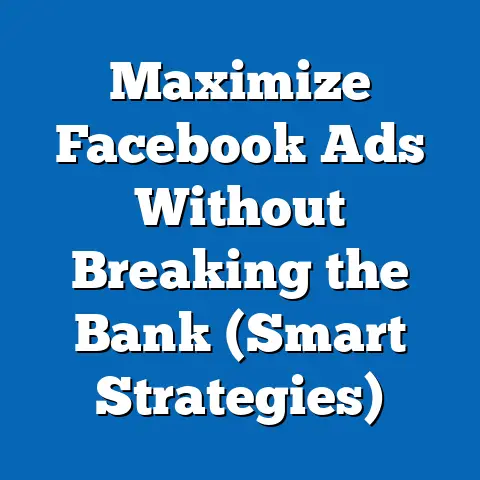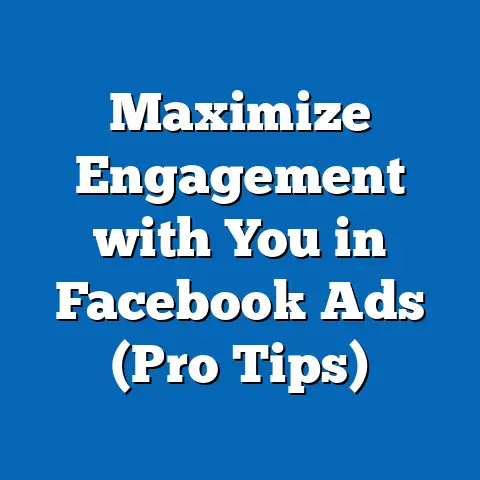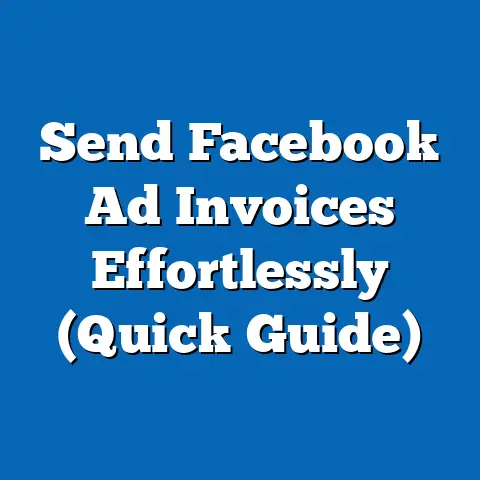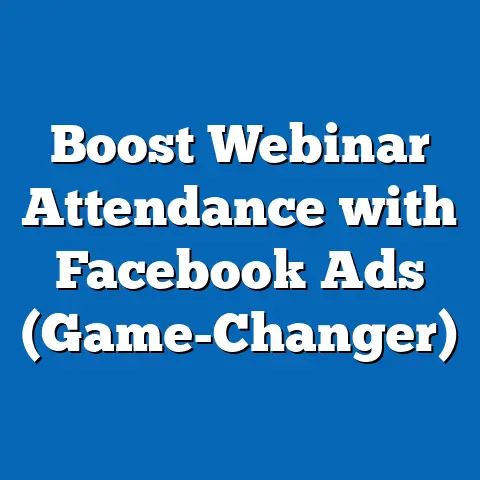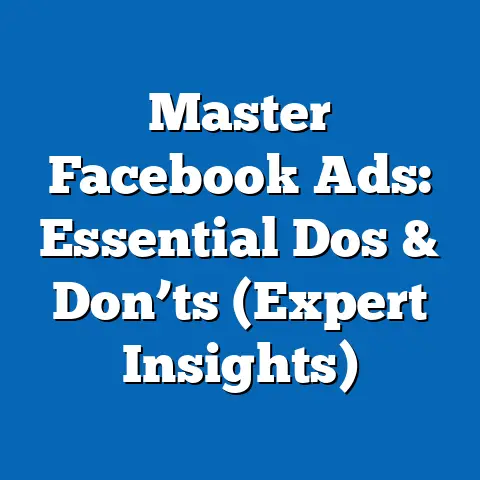Transform 60-Minute Facebook Ads for Trump Campaign (Proven Strategies)
In today’s hyper-connected world, social media advertising has become an indispensable tool for political campaigns. Gone are the days of relying solely on traditional media outlets; now, reaching voters directly through platforms like Facebook is not just an option, but a necessity. The Trump campaign, known for its innovative and often disruptive approach to political marketing, has consistently leveraged the power of Facebook ads to engage supporters, sway undecided voters, and ultimately, drive electoral success.
Over the years, Facebook ads have evolved from simple text-based messages to sophisticated, highly targeted campaigns capable of delivering personalized content to specific demographic groups. This evolution has made Facebook an even more powerful tool for political strategists, but it also requires a deeper understanding of the platform’s capabilities and a more nuanced approach to ad creation.
Enter the concept of the “60-Minute Facebook Ad.” In a world of fleeting attention spans, capturing a user’s interest within the first minute is crucial. This article aims to provide proven strategies for transforming standard Facebook ads into powerful, attention-grabbing tools that can effectively communicate the Trump campaign’s message and mobilize its base. I’ll delve into the latest trends in Facebook advertising, examine the unique positioning of the Trump campaign, and offer actionable insights into crafting compelling narratives, leveraging targeted audience segmentation, utilizing engaging visual and audio elements, incorporating persuasive call-to-actions, and analyzing performance metrics.
From my own experience in digital marketing, I’ve seen firsthand how a well-crafted, strategically targeted Facebook ad can make a significant impact on a campaign’s success. It’s not just about throwing money at the platform; it’s about understanding the nuances of the audience, the power of storytelling, and the importance of continuous optimization. So, let’s dive in and explore how to transform your Facebook ads into potent weapons in the Trump campaign’s arsenal.
Current Trends in Facebook Advertising
The landscape of Facebook advertising is constantly shifting, especially in the political arena. What worked yesterday might not work today, and what works today might be obsolete tomorrow. Staying ahead of the curve requires a keen understanding of the latest trends and a willingness to adapt your strategies accordingly.
One of the most significant trends I’ve observed is the shift towards short, impactful video content. People are bombarded with information every day, and their attention spans are shrinking. Long, drawn-out ads are simply not effective anymore. Instead, campaigns are focusing on creating concise, visually appealing videos that can quickly grab attention and convey a key message. Live streaming events have also gained immense popularity, offering a more interactive and engaging way to connect with voters.
Another crucial trend is the rise of targeted advertising and AI-driven personalization. Facebook’s sophisticated targeting capabilities allow campaigns to reach specific demographic groups with tailored messages. AI algorithms can analyze user data to identify patterns and predict voter behavior, enabling campaigns to deliver highly personalized ads that resonate with individual users. This level of personalization can significantly increase engagement and conversion rates.
According to a recent study by Statista, political advertising spending on social media platforms is projected to reach \$1.6 billion in 2024, with Facebook accounting for a significant portion of that spending. This demonstrates the growing importance of Facebook ads in modern political campaigns. Furthermore, data from the 2020 election cycle showed that the Trump campaign spent significantly more on Facebook ads than the Biden campaign, highlighting their strategic focus on this platform.
However, it’s also important to acknowledge the challenges and limitations of Facebook advertising. Social media platforms are under increasing pressure to combat misinformation and enhance transparency in political advertising. Facebook has implemented stricter policies and verification processes to prevent the spread of false or misleading information. This means that campaigns need to be extra careful about the content they create and the claims they make in their ads.
Moreover, the public’s trust in social media platforms has been declining in recent years, particularly among younger demographics. This means that campaigns need to work harder to build trust and credibility with their audience. Transparency, authenticity, and a genuine commitment to addressing voter concerns are essential for overcoming this challenge.
Key Takeaway: Stay informed about the latest trends in Facebook advertising, embrace short-form video content, leverage targeted advertising and AI-driven personalization, and prioritize transparency and authenticity to build trust with your audience.
Understanding the Trump Campaign’s Unique Position
The Trump campaign operates in a unique space within the political landscape. It’s crucial to understand these unique attributes to tailor Facebook advertising strategies effectively. Trump’s appeal stems from several factors, including his populist message, his strong stance on certain issues, and his ability to connect with a particular segment of the electorate.
One of the defining characteristics of the Trump campaign is its focus on appealing to working-class voters, particularly in traditionally Democratic states. This demographic group often feels overlooked and underserved by the political establishment, and Trump’s message of economic nationalism and job creation resonates strongly with them.
Trump’s brand persona is another critical factor to consider. He is known for his outspokenness, his willingness to challenge conventional wisdom, and his unapologetic defense of his views. This persona has both attracted and repelled voters, but it has also created a strong sense of loyalty among his base.
Therefore, Facebook ads for the Trump campaign should be tailored to reflect these unique attributes. They should focus on communicating a clear and consistent message that resonates with the target audience. They should also reflect Trump’s brand persona, showcasing his strengths and addressing his weaknesses.
For example, the Trump campaign could use Facebook ads to highlight his accomplishments in office, such as the creation of jobs, the reduction of taxes, and the appointment of conservative judges. They could also use ads to attack his opponents, portraying them as out of touch with the concerns of ordinary Americans.
In past campaigns, the Trump team has effectively utilized Facebook to create highly targeted ads focusing on specific demographics and interests. For instance, ads targeting veterans emphasized his support for the military, while ads targeting business owners focused on his pro-business policies. This granular approach allowed them to tailor their message for maximum impact.
Key Takeaway: Understand the unique attributes of the Trump campaign, including its populist message, its appeal to working-class voters, and Trump’s brand persona. Tailor your Facebook ads to reflect these attributes and resonate with the target audience.
Proven Strategies for 60-Minute Facebook Ads
Now, let’s dive into the specific strategies you can use to transform your Facebook ads into powerful tools for the Trump campaign. These strategies are based on my experience in digital marketing, as well as insights from successful political campaigns.
4.1. Crafting Compelling Narratives
Storytelling is a powerful tool for connecting with voters on an emotional level. People are more likely to remember and be persuaded by a story than by a list of facts and figures. Therefore, crafting compelling narratives is essential for creating effective Facebook ads.
A successful narrative typically follows a clear structure:
- Identify the problem: What is the issue that the Trump campaign is trying to address?
- Introduce the hero: How is Trump working to solve this problem?
- Present the solution: What are the specific policies or actions that Trump is proposing?
- Call to action: What can voters do to support Trump’s efforts?
For example, a narrative could focus on the issue of illegal immigration. The problem could be defined as the strain that illegal immigration puts on the economy and the social fabric of the country. Trump could be presented as the hero who is working to secure the border and deport illegal immigrants. The solution could be the construction of a border wall and the implementation of stricter immigration laws. The call to action could be for voters to support Trump in the next election.
In the 2016 election, the Trump campaign effectively used narratives that played on voter anxieties about economic decline and national security. These narratives resonated with a specific segment of the electorate and helped to propel Trump to victory. Understanding these narratives is key to replicating that success.
Key Takeaway: Use storytelling to connect with voters on an emotional level. Craft compelling narratives that follow a clear structure and resonate with the target audience.
4.2. Leveraging Targeted Audience Segmentation
Facebook’s targeting capabilities are one of its greatest strengths. By segmenting your audience, you can deliver highly personalized ads that resonate with specific demographic groups.
Here are some of the key targeting options available on Facebook:
- Demographics: Age, gender, location, education, income, etc.
- Interests: Hobbies, activities, pages they like, etc.
- Behaviors: Purchase history, online activity, etc.
- Custom Audiences: Upload a list of email addresses or phone numbers to target existing customers or supporters.
- Lookalike Audiences: Create a new audience that is similar to your existing customers or supporters.
For the Trump campaign, some of the key demographic segments to target might include:
- Working-class voters: Focus on economic issues and job creation.
- Veterans: Emphasize support for the military and national security.
- Small business owners: Highlight pro-business policies and tax cuts.
- Evangelical Christians: Focus on social issues and religious freedom.
By creating different ad campaigns for each of these segments, you can tailor your message to their specific interests and concerns.
For example, an ad targeting working-class voters could focus on the number of jobs that have been created under Trump’s leadership. An ad targeting veterans could feature testimonials from veterans who support Trump. An ad targeting small business owners could highlight the benefits of Trump’s tax cuts for small businesses.
Key Takeaway: Leverage Facebook’s targeting capabilities to segment your audience and deliver highly personalized ads that resonate with specific demographic groups.
4.3. Utilizing Engaging Visual and Audio Elements
In the age of social media, visual and audio elements are essential for capturing attention and conveying your message effectively. People are more likely to engage with ads that are visually appealing and that use sound to enhance the message.
Here are some tips for utilizing engaging visual and audio elements in your Facebook ads:
- Use high-quality images and videos: Avoid using blurry or pixelated images.
- Keep it short and sweet: Aim for videos that are 15-30 seconds long.
- Use captions: Many people watch videos on mute, so it’s important to include captions.
- Use music and sound effects: Music and sound effects can help to create an emotional connection with your audience.
- Use animation: Animation can be a great way to capture attention and explain complex concepts.
The Trump campaign has been particularly effective at using visuals that evoke strong emotions, such as images of American flags, military personnel, and patriotic symbols. They have also used audio to create a sense of urgency and excitement.
For example, one of the Trump campaign’s most successful ads featured a montage of images and videos set to upbeat music. The ad highlighted Trump’s accomplishments in office and portrayed him as a strong and decisive leader.
Key Takeaway: Utilize engaging visual and audio elements to capture attention and convey your message effectively. Use high-quality images and videos, keep it short and sweet, use captions, and use music and sound effects to create an emotional connection with your audience.
4.4. Incorporating Call-to-Actions
A call-to-action (CTA) is a prompt that tells your audience what you want them to do next. Without a clear CTA, your ad is unlikely to achieve its desired results.
Here are some examples of effective CTAs for Facebook ads:
- Donate: Encourage people to donate to the Trump campaign.
- Volunteer: Recruit volunteers to help with the campaign.
- Sign up: Encourage people to sign up for the Trump campaign’s email list.
- Learn more: Direct people to the Trump campaign’s website to learn more about his policies.
- Share: Encourage people to share the ad with their friends and family.
The CTA should be clear, concise, and compelling. It should also be relevant to the content of the ad.
For example, an ad that highlights Trump’s economic policies could include a CTA that encourages people to “Learn more about Trump’s plan to create jobs.” An ad that features testimonials from veterans could include a CTA that encourages people to “Support Trump’s commitment to our military.”
Key Takeaway: Incorporate clear, concise, and compelling CTAs in your Facebook ads. Make sure the CTA is relevant to the content of the ad and tells your audience what you want them to do next.
4.5. Analyzing Performance Metrics
Measuring the effectiveness of your Facebook ads is essential for optimizing your campaigns and achieving your desired results. Facebook provides a wealth of data that you can use to track the performance of your ads.
Here are some of the key metrics to track:
- Reach: The number of people who saw your ad.
- Impressions: The number of times your ad was displayed.
- Click-through rate (CTR): The percentage of people who clicked on your ad.
- Cost per click (CPC): The average cost of each click on your ad.
- Conversion rate: The percentage of people who took the desired action after clicking on your ad.
- Cost per conversion (CPC): The average cost of each conversion.
By tracking these metrics, you can identify which ads are performing well and which ads need to be improved. You can also use A/B testing to experiment with different ad copy, visuals, and targeting options to see what works best.
For example, the Trump campaign could use A/B testing to compare different versions of an ad that highlights his economic policies. They could test different headlines, images, and CTAs to see which version generates the most clicks and conversions.
Key Takeaway: Analyze performance metrics to measure the effectiveness of your Facebook ads. Track reach, impressions, CTR, CPC, conversion rate, and CPC. Use A/B testing to experiment with different ad elements and optimize your campaigns for maximum results.
5. Case Studies of Successful Facebook Ads
To further illustrate these strategies, let’s examine some case studies of successful Facebook ad campaigns from the Trump campaign.
One notable example is the campaign that focused on reaching working-class voters in key swing states. The ads featured images of Trump visiting factories and meeting with workers, accompanied by slogans like “Bringing Jobs Back to America” and “Making America Great Again.” These ads were highly targeted to voters in areas with high unemployment rates and a history of supporting Democratic candidates. The results were impressive, with the Trump campaign significantly increasing its support among working-class voters in these states.
Another successful campaign focused on mobilizing evangelical Christians. The ads featured images of Trump meeting with religious leaders and attending church services, accompanied by slogans like “Protecting Religious Freedom” and “Standing Up for Traditional Values.” These ads were highly targeted to voters who identified as evangelical Christians and who had a history of voting Republican. The results were equally impressive, with the Trump campaign significantly increasing its turnout among evangelical Christians.
These case studies demonstrate the power of targeted advertising and compelling narratives. By understanding the needs and concerns of specific demographic groups and crafting ads that resonate with them, the Trump campaign was able to achieve significant electoral success.
Key Takeaway: Study successful Facebook ad campaigns from the Trump campaign to learn from their successes and avoid their mistakes. Pay attention to the strategies they used, the target demographics they focused on, and the results they achieved.
6. Conclusion
Facebook advertising is a powerful tool that can be used to influence voter behavior and drive electoral success. However, it’s important to remember that Facebook advertising is not a silver bullet. It requires a deep understanding of the platform’s capabilities, a nuanced approach to ad creation, and a willingness to adapt your strategies to the ever-changing political landscape.
By following the strategies outlined in this article, you can transform your Facebook ads into potent weapons in the Trump campaign’s arsenal. Craft compelling narratives, leverage targeted audience segmentation, utilize engaging visual and audio elements, incorporate persuasive call-to-actions, and analyze performance metrics to optimize your campaigns for maximum results.
As I’ve seen throughout my career, the future of Facebook advertising in politics is likely to be shaped by several key trends, including the rise of AI-driven personalization, the increasing importance of short-form video content, and the growing demand for transparency and authenticity. Campaigns that can successfully adapt to these trends will be best positioned to succeed in the years to come. So, embrace the challenge, experiment with new strategies, and never stop learning. The future of Facebook advertising is in your hands.

